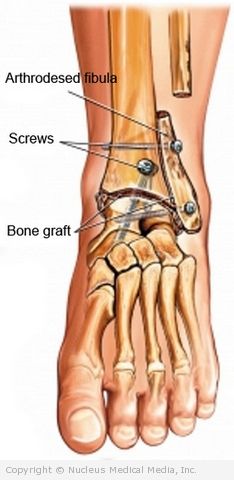Arthrodesis of foot and ankle – open surgery
Arthrodesis of foot and ankle – open surgery – Definition
Arthrodesis fuses (welds) together the two bones that form a joint. There is no longer movement in the joint after the procedure. One or more related joints may be done at the same time.
Arthrodesis of foot and ankle – open surgery – Reasons for Procedure
Ankle arthrodesis is used to relieve disabling ankle pain or deformity caused by poorly healed fractures, arthritis, infections, or developmental defects.
Satisfactory results, including good pain relief, are achieved in most patients. Most can wear ordinary shoes. Some will benefit from specially fitted footwear.
Arthrodesis of foot and ankle – open surgery – Possible Complications
Complications are rare, but no procedure is completely free of risk. If you are planning to have an arthrodesis, your doctor will review a list of possible complications, which may include:
- Failure of the joint to fuse
- Poor alignment of the joint, causing pain and/or an altered gait
- Need for repeat surgery
- Infection
- Bleeding
- Nerve damage
Factors that may increase the risk of complications include:
- Smoking
- Infection
- Some chronic diseases
- Steroid medicines
Arthrodesis of foot and ankle – open surgery – What to Expect
Prior to Procedure
Several nonsurgical treatments will be tried to correct the problem before choosing surgery. These may include medicines, injections, special shoes, or types of physical therapy. You will have a thorough evaluation to determine your overall health and any risk factors.
Talk to your doctor about your medicines. You may be asked to stop taking some medicines up to one week before the procedure, like:
- Aspirin or other anti-inflammatory drugs
- Blood thinners, such as warfarin (Coumadin)
- Clopidogrel (Plavix)
Do not eat or drink anything after midnight the day before your surgery, unless told otherwise by your doctor.
Arrange for help at home after returning from the hospital.
Arthrodesis of foot and ankle – open surgery – Anesthesia
Your doctor may choose:
- General anesthesia — You will be asleep.
- Spinal anesthesia — Anesthesia will be given directly into the spine; your lower body will be numb.
Arthrodesis of foot and ankle – open surgery – Description of the Procedure
The doctor will make a long incision so that he can see the joint. He will then secure the joint. There are many ways to secure the two bones together so that they no longer move in relation to one another. Long screws, screws and steel plates, long steel rods, and bone grafts have all been used.
You will have a tourniquet strapped around your thigh to shut off circulation so that the surgery can be performed in a bloodless field. Your leg will not suffer ill effects from the tourniquet.
Arthrodesis of foot and ankle – open surgery – Immediately After Procedure
Your lower leg will be in a rigid cast and be elevated after surgery. You will be offered pain medicine.
Arthrodesis of foot and ankle – open surgery – How Long Will It Take?
About 2-3 hours
Arthrodesis of foot and ankle – open surgery – How Much Will It Hurt?
There will be no pain during the procedure. Afterwards, there will be some discomfort. Talk to your doctor about medicine to help manage discomfort.
Arthrodesis of foot and ankle – open surgery – Average Hospital Stay
Barring complications, you may be able to go home in 2-4 days.
Arthrodesis of foot and ankle – open surgery – Postoperative Care
It will take up to four months to heal and solidly fuse the joint(s). During that time, you will be in a cast. After the procedure, be sure to follow your doctor’s instructions. Ask your doctor about when it is safe to shower, bathe, or soak in water.
Arthrodesis of foot and ankle – open surgery – Call Your Doctor
After you leave the hospital, contact your doctor if any of the following occurs:
- Bleeding or discharge from your incision(s). This may show up as staining of your cast.
- Signs of infection, including fever and chills
- Increasing or severe pain that is not relieved by your pain medicine
- Cough, shortness of breath, chest pain, or severe nausea and vomiting
- Numbness, tingling, or discoloration in the foot
In case of an emergency, call for medical help right away.

